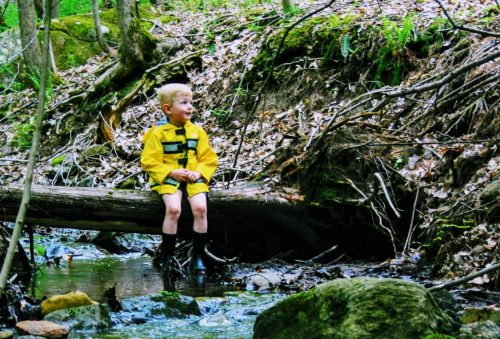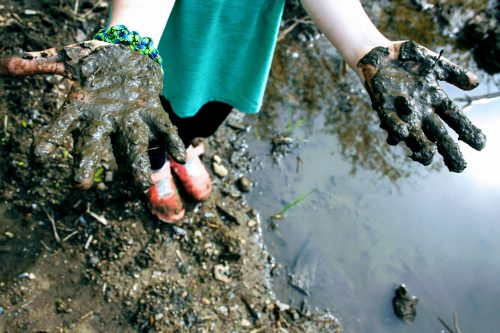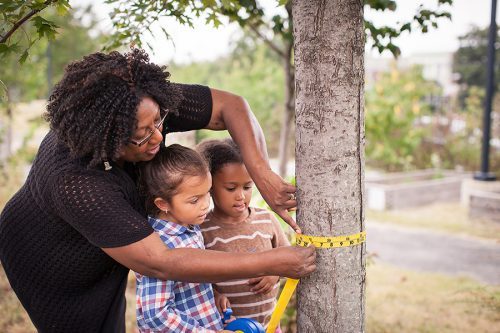Springtime brings about longer days, new bursts of life, and the feeling of a fresh new start.
It’s also a great time for educators, parents, and children to stretch their legs outdoors. Although this spring may be a bit different, due to Covid-19, we should all be committed to getting kids interested and excited about nature – whether in their own backyards or around their neighborhoods.
Here are 11 tips to help parents connect children to the outdoors:
-
 Create distraction-free adventures
Create distraction-free adventures
Most young children have never known a world without technology at their fingertips. Challenge yourself and your kids to experience 1-2 outings a week where you leave your devices at home. If you prefer to bring along your cellphone for safety reasons, be a role model and avoid texting, making calls or taking excessive photos. Get as close as possible to trees and wildlife. Immerse yourselves in the chirps, cracks and rustlings with all your senses instead.
-
Listen to Nature
Nature provides us with many unforgettable sounds, from leaves rustling to birds singing to streams gurgling. Download our free “Sounds Around” family activity to engage children in the sounds of nature.
Want to see a demonstration? Check out this video from Colorado PLT Coordinator Danielle Ardrey with step by step instructions, some guiding questions for children, and see her “sound map” she created in her backyard.
-
 Encourage unstructured play
Encourage unstructured play
Let kids use their creativity and innovation by encouraging unstructured play outdoors. Look under small logs, make stick houses decorated with leaf flags, stir up some delicious mud soup, and collect little treasures like rocks and feathers. The only rule should be to have fun!
-
Use tech to teach
How many kids can look at a tree and name its species? Download our free “Name That Tree” family activity in which we challenge kids to look at trees more closely and to use smartphones to identify them and learn about the products they make.
Want to see a demonstration? Check out this video from Florida PLT Facilitator Kirsten Brazier and her daughter using the activity to identify trees in their own backyard.
-
 Tell stories and sing songs
Tell stories and sing songs
In many cultures, the passing down of oral stories helps people stay connected to their culture and to the land. Are there stories or songs you know that speak to the importance of nature and animals? By sharing these songs and stories with your children, you will plant the seed of stewardship and help them feel more connected to nature.
Want some recommendations for children’s books suitable for elementary and middle school students?
A Walk on the Tundra is a glimpse into traditions of the arctic tundra as a native Inuit child takes a morning walk with her grandmother.
Wishtree helps a Muslim family move into a new community with the help of stories from different families over multiple generations overhead by a 216-year-old oak tree named Red.
In Circle Unbroken, an African-American grandmother interweaves stories of her family’s ancestry and culture as she shows her granddaughter how to weave a traditional Gullah basket.
-
Inspect new life in your backyard
Spring is a great time to observe new growth. Download our free “Bursting Buds” activity to teach kids the ins and outs of tree twigs and how leaves are formed.
-
 Establish a nature routine
Establish a nature routine
Create a routine that incorporates a little bit of nature every day. It could be as simple as eating lunch outdoors, getting some fresh air and soaking up a little vitamin D, or as active as a 30-minute family stroll around the neighborhood after work. Here are a few nature walk activity ideas to get you started!
-
Create a nature calendar
This activity works best with the “Nature routine” we suggested above. Create a blank calendar (either by hand or with a free tool like print-a-calendar.com). Decorate it together with drawings or images of the things you find while exploring the outdoors, like trees, squirrels, ants and flowers. Hang your calendar in a space where your children can see it every day and get excited about their next outdoor activity.
-
Adopt a tree
Next time you venture out into your backyard or stroll around your neighborhood, have children observe the trees around them. Have they ever stopped to consider their favorite? Download our free “Adopt a Tree” activity to help children gain a deeper awareness of individual trees and how they can change over time. Virginia PLT Coordinator, Page Hutchinson recently demonstrated this activity in action – check out the video and follow along at home!
-
 Learn the value of a tree
Learn the value of a tree
Trees are fascinating living organisms. They provide us with food for eating, lumber for our homes, paper to write on, and thousands of other things we use every day. They also sequester CO2, help to decrease storm water runoff, and provide shelter to wildlife. Download our free “What’s the value of that tree” activity, in which children can produce “nutrition-style” labels that list the benefits of a tree.
-
Connect with nature indoors
Have you seen our highlight of 9 free PLT family activities for kids to try at home? Another idea is to watch an educational documentary about nature, wildlife, and forests; if you can’t spend time outdoors, you could connect with nature while learning a lot from these films. There are also a number of National Parks offering “virtual visits” to historic outdoor sites. Afterwards, talk to your kids about what they saw. What did they retain from these activities, films, and tours? How did it impact them?
Let us know if you use any of these tips by tagging us in a photo on Facebook or by sending an email to [email protected].
Note from the editor: This article was adapted from an article published by PLT Canada; view the original article here.


